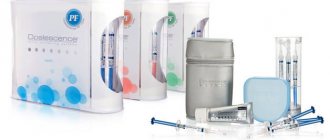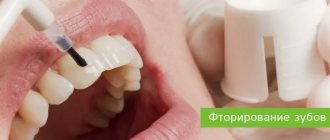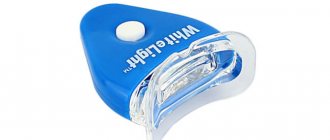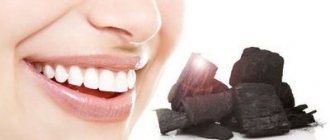Author of the article:
Soldatova Lyudmila Nikolaevna
Candidate of Medical Sciences, Professor of the Department of Clinical Dentistry of the St. Petersburg Medical and Social Institute, Chief Physician of the Alfa-Dent Dental Clinic, St. Petersburg
Everyone wants to have healthy teeth, and even better, they are not only strong, but also snow-white. Achieving this, of course, is not easy. Normal enamel initially has a yellowish tint due to the dentin showing through underneath it. In addition, over time, teeth become darker. This happens because their top layer is quite porous and absorbs dyes from food well. Coffee, black tea, chocolate, berries and fruits, colored sodas, as well as other products gradually add color to the enamel. Plus, plaque gradually accumulates on the teeth, which can only be removed by professional cleaning.
I want to get rid of all this, and today there are many ways to do this. All of them can be divided into two large groups: professional whitening and traditional methods. Let's talk about the latter, namely how to whiten teeth using various essential oils, talk about the dangers and benefits, and share interesting recipes.
Healing properties of tea tree
Tea tree oil is a medicinal substance that is produced from the Melaleuca Alternifolia plant, native to Australia. This natural drug has proven itself not only in folk medicine, but also in official medicine. Due to its healing properties, the product is often used in dentistry. It successfully fights pathogenic microbes living in the oral cavity, stops inflammatory processes, and soothes irritated mucous membranes. You can purchase this drug at almost any pharmacy. Many people suffering from various skin or fungal infections, ringworm, know about the antifungal and antiviral properties of the oil, so they use it to solve their health problems. The product is also suitable for treating dandruff and scalp care. Dentists value melaleuca oil for its healing properties, which is why they recommend it to their patients.
Attention! Using oil to remove yellow stains from tooth enamel is a gentle and gentle whitening method. The product does not contain abrasives or aggressive components that can damage the dental coating, so it can be used without fear. The active components of the oil soften dental plaque, returning the enamel to its natural color. Tea tree has antimicrobial, anti-inflammatory, regenerative, and soothing properties. The beneficial substances in its composition have a detrimental effect on fungi and microbes, soothe irritation, relieve inflammation, and accelerate the healing process of wounds.
Melaleuca is a species of plant from which “tea tree oil” is obtained, which has excellent anti-inflammatory and bactericidal properties. Research has shown that the leaves of this plant contain caffeine, tannin, and many vitamins, much more than lemon.
Since the drug is rich in useful substances, it is used not only to return teeth to their natural color, but also to treat and prevent certain dental diseases. What problems does this remedy help eliminate?
- Inflammatory gum diseases. Tea tree has a beneficial effect on gums, soothing them and eliminating bleeding. In Australia, dentists often recommend this product to their patients as part of their mouthwash.
- Tartar. The active components of melaleuca oil dissolve soft and old, hardened plaque. By regularly using this remedy, you can gradually get rid of tartar.
- Bad breath. This problem causes a lot of inconvenience not only to the person himself, but also to the people with whom he communicates. The cause of the unpleasant odor is the waste products of pathogenic microorganisms that actively multiply in the mouth during various diseases. Thanks to its disinfecting properties, the oil perfectly refreshes and heals the oral cavity and helps destroy pathogenic bacteria.
- Caries. Cariogenic bacteria living in the human mouth destroy tooth enamel, causing the development of such a common disease as caries. Almost every person is susceptible to it to one degree or another.
Attention! To prevent the development of caries, you can supplement your hygiene procedures with the use of melaleuca oil. To increase the effectiveness of its effects, it can be used in combination with plants such as horsetail, neem, and burdock.They are rich in antimicrobial, wound-healing and other substances that restore the microflora of the oral cavity, favorably affecting dental and gingival tissue.
Minuses
No matter how many positive aspects there are to whitening tooth enamel with oil, there is still a fly in the ointment:
- It will not be possible to achieve snow-whiteness. Using this method of whitening, you can return only the natural shade of the enamel. For a Hollywood smile, you will have to use professional lightening using special preparations.
- Eating products containing dyes and smoking will cause yellowing of the enamel.
- The first three minutes after the manipulations, the tongue goes numb, and taste perception changes.
- Not everyone likes a specific scent.
Another disadvantage is that if the bleaching agent gets into the stomach, nausea may occur.
How to whiten teeth with tea tree oil
There are many ways to use the product. If you don’t have the time or desire to look for some complex recipes, it is recommended to simply pour 2-3 drops of oil into toothpaste and use it to brush your teeth. You can drip some oil onto your brush and brush your teeth without toothpaste. Another option is to use the product as a rinse aid. To do this, you will need half a glass of mineral water, to which you need to add 2-3 drops of oil. Rinse your mouth with this solution after brushing. You can also apply the drug to your teeth with a small piece of cotton wool or gauze, rub it in gently, wait a few minutes for the active ingredients to take effect, and then rinse your mouth with water. It is not recommended to eat immediately after whitening. To get results, you need to wait some time for the product to act on the tooth covering. In addition, after brushing, the taste of oil is felt in the mouth and can spoil the taste of food. Let's take a closer look at how to properly whiten your teeth. First of all, you need to thoroughly clean your teeth with a brush and toothpaste to remove the bulk of plaque and remove food debris. Then drop two or three drops of oil onto the washed brush. Clean again. After this, remove the oil by rinsing your mouth with water.
Tea tree oil is actively used in dentistry; in addition to whitening, it has an antiseptic and antibacterial effect, has a beneficial effect on the condition of the gums, and reduces their bleeding.
When using tea tree oil, follow the dosage. Just a few drops are enough, because the product is quite concentrated. If you exceed the dose, you may experience discomfort in your mouth. After the first uses, some numbness may be felt on the tongue. After the procedure, you should rinse your mouth well with water.
Important! It is best to choose good quality undiluted oil. It costs more, but the effect is much better than a cheap product.
To achieve results, you need to do the above procedure daily. The result will be noticeable within a week. After this, it will be enough to use this method a couple of times a week. Regular use of the product will keep your teeth in good condition.
Influence
The oils contain several active ingredients that have a positive effect on teeth. However, the greatest effect in the treatment of toothache is achieved by using mint and clove oils. Through their anesthetic effect, they numb the nerve for a while. The procedure for using the product is as follows: you need to apply a cotton swab to the inflamed area for a while, moistening it with a composition of several types of oils. Hold the tampon until it becomes easier.
Lavender essential oil is a soothing, analgesic, antispasmodic, anti-migraine agent, and also has a pronounced antimicrobial property.
To prepare one of the most effective compositions, you need to mix a few drops of the following oils:
- Mint;
- Lavender;
- Carnations.
Next, the composition is mixed with 1 teaspoon of almond oil. The moistened cotton wool is applied to the inflamed area. In order to relieve acute pain, you can add chamomile to the mixture. Fir is often used to combat viruses and other harmful microorganisms. However, when using it, care must be taken, otherwise you are likely to get a burn to the oral mucosa. To treat a diseased tooth, cotton wool is applied to it every five hours for about three minutes.
What effect should you expect?
If you carry out the manipulations described above for a week, visible results will not be long in coming. At first, many people feel a slight numbness on the tongue or an unpleasant taste in the mouth, but over time these sensations disappear and the enamel becomes noticeably lighter. How much teeth will be cleaned will depend on their natural color and the amount of deposits. During the whitening process, beneficial substances penetrate the gums, strengthening and healing them. Hard dental plaque gradually dissolves. After a week-long course of whitening, the effect already becomes noticeable. To maintain and improve the results, you must continue to periodically brush your teeth with tea tree oil. This will help get rid of various dental problems, strengthen tooth enamel and gums.
Tea tree essential oil for teeth has a number of beneficial properties - it gently whitens the enamel to a natural shade and cleanses teeth from plaque, in which pathogenic microorganisms that cause gum inflammation multiply.
Application
Most often, dental diseases and inflammation of the gums are treated with rinsing solutions based on essential oils for teeth or special applications:
a) Rinse
In order to rinse the mouth, it is necessary to prepare a special solution based on soda or salt in the ratio of one teaspoon of the bulk component per glass of warm water, to which a certain amount of any essential oil for teeth is subsequently added. A quick result will be available if you rinse every hour every day.
b) Applications
The universal method of preparing applications is as follows:
- Essential oil for teeth in the amount of 5 drops is dissolved in 10 ml of alcohol or cold-pressed vegetable oil.
- A cotton swab is moistened in the resulting solution and then applied to the sore spot.
- The application time for this application is 15 minutes.
Treatment of oral diseases with tea tree oil
In addition to teeth whitening, you can use tea tree oil to treat dental diseases. Let's look at what other recipes exist for teeth whitening and solving other dental problems.
- If your tooth enamel has acquired a dark or yellowish tint, you should add a drop of melaleuca oil to the paste during your morning brushing.
- Tea tree in combination with aloe juice strengthens teeth, reducing their sensitivity to irritants. To do this, mix a little aloe pulp with a few drops of oil. Apply this mixture to the teeth and gums, rubbing in with gentle movements.
- If the tooth is inflamed and gumboil has developed, tea tree oil will relieve pain and suppuration. To do this, you need to drop 5-6 drops of the drug into a cup of warm water, stir and use for rinsing several times a day until the inflammation goes away.
- If the gums are swollen or inflamed, you need to drop a few drops of oil on a piece of cotton wool and apply to the sore area. After some time, the inflammation will decrease.
- Another way to quickly whiten your teeth is to use tea tree oil along with baking soda. Take a small pinch of baking soda and mix with two drops of oil. Rub the resulting mixture into your teeth after regular brushing. After the procedure, you need to rinse your mouth with water.
- For smokers who want to clean their teeth from the yellow stains left by nicotine, there is also a recipe. Dilute one drop of oil in a teaspoon of mineral water and wipe the surface of your teeth with it three times a day after meals.
Tooth powder with tea tree essential oil is one of the most common teeth whitening recipes. You need to wet your toothbrush, dip it in tooth powder, drip tea tree on top and brush your teeth, then rinse your mouth with a water solution of baking soda.
For children
Lavender and chamomile are especially useful for parents during the period when their children begin to teethe. In order to avoid allergies, you should first consult your doctor. 3 Recipe When children's teeth grow, it is recommended to use the following: mix 1 drop of lavender or chamomile with 5 ml of any essential oil of your choice. The mixture is brought to room temperature and massaged onto the cheek near the ear, where the growing tooth is located.
Chamomile oil is considered one of the best calming tools. It brings relaxation and peace on both the physical and emotional levels, perfectly relieves excitement and irritation, and allows you to quickly cope with anxiety and tension.
It is important to know that essential oils cannot be given to children in their pure form! Ordinary ones are possible, but before use, consultation with a specialist is necessary for the possible manifestation of allergic reactions, which can occur in both children and adults.
Contraindications to use of the product
Despite the abundance of medicinal properties, tea tree has some contraindications that must be studied before you start using the product. The use of oil is contraindicated:
- people who are allergic to thyme or celery (melaleuca can also cause allergic reactions);
- women during pregnancy and breastfeeding;
- children and adolescents under 16 years of age.
Allergies to tea tree oil are very rare, but before use it is still worth testing for allergies.
It is advisable to use tea tree oil for no longer than two weeks in a row. Otherwise, you can get the opposite effect – thinning of the enamel and increased tooth sensitivity.
Advantages
Despite the fact that it is possible to lighten enamel faster and more effectively by other means, oil has a number of advantages:
- natural lightening composition;
- does not injure and has a gentle effect on soft tissues and enamel due to the absence of mechanical influence on them;
- can be used even for stomatitis, periodontitis, gingivitis;
- does not cause irritation to the mucous membrane, but promotes its nutrition and healing in case of existing diseases;
- availability of lightening at home with minimal investment of time and money;
- ease of implementation;
- no side effects.
All of the listed advantages of the product make it one of the most common and popular.
Recommendations for using the product
In order for treatment and teeth whitening to be effective, it is necessary to purchase high-quality, undiluted oil. It has a higher cost, but is still cheaper than many professional teeth whitening products.
Important! Since the product is very concentrated, there is no need to use large quantities. Just a couple of drops are enough for use.
You should not eat food immediately after the procedure, otherwise the entire effect will be reduced to zero. You need to wait a while for the active ingredients to take effect. During the first use, you may experience an unpleasant taste in the mouth and slight numbness of the tongue. To eliminate these sensations, just rinse your mouth thoroughly with plenty of water. Even if you are not worried about any dental problems, you can use a product to prevent dental diseases. Since tea tree oil is used very sparingly, one bottle purchased at a pharmacy will be enough to whiten teeth for a long time.
It is not advisable to use a concentrated solution of tea tree; it is best to dilute one drop of oil with vitamin E oil. Tea tree oil is also widely used in combination with other essential oils to prepare mouth rinses.
General information
Melaleuca is an exclusively Australian plant. After water distillation, valuable essential oil is obtained from the juice of the leaves. It is a clear, light yellow liquid with an odor combining camphor and wood.
Containing a huge number of terpineols, it has powerful antimicrobial, anti-inflammatory, wound-healing, and soothing effects. Aborigines have used it since ancient times to cure serious illnesses, skin diseases, bites and burns.
Today its beneficial properties are used in medicine and cosmetology. It is an integral component of many cosmetics and medications.
The main use of the oil was as a teeth-lightening agent. Their tone changes when plaque is removed, which often causes the enamel to darken.











